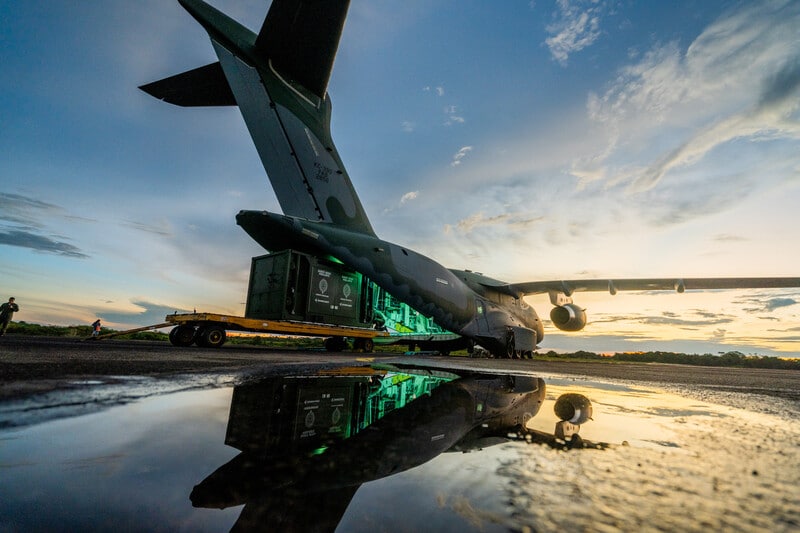Aerospace
Embraer and the Brazilian Army successfully complete the first test of M200 Vigilante radar

Embraer and the Brazilian Army have successfully completed the first test of the M200 Vigilante radar, which included the deployment of the equipment on a Brazilian Air Force (FAB) KC-390 aircraft. During June and July, the radar operation was carried out at Jlio Belém Airport in Parintins. The proposal was also backed by Parintins City Hall, Jlio Belém Airport, and Viracopos International Airport.
RAF A400M flies 22 Hours nonstop from the United Kingdom to Guam(Opens in a new browser tab)
The Parintins Folkloric Festival, an occasion that significantly increases air traffic in the area, is why the location was picked. Through Jlio Belém Airport, thousands of tourists entered the city this year, resulting in more than 800 landings and takeoffs in a single week.
On a three-hour flight from Campinas, in So Paulo state, to the city situated in the Amazon jungle, the M200 Vigilante radar was flown for the first time on a KC-390. The sensor, in collaboration with CINDACTA IV flight controllers, continuously monitored aviation traffic within a 200 km radius of the airport. The Brazilian Air Force division CINDACTA IV is in charge of keeping an eye on flights in the north of the country.
The Brazilian armed forces acquire 27 H125 helicopters(Opens in a new browser tab)
A medium-range sensor designed for Air Surveillance and Early Warning purposes is the M200 Vigilante radar. It can recognise and track positions and trajectories, as well as classify targets, using cutting-edge processing algorithms. It contains an integrated power generation system that ensures up to 48 hours of operation autonomy and facilitates transportation by land and air platforms.

Aerospace
Boeing Transfers Rocket Stage to NASA, Paving Way for Human Moon Mission

Boeing has achieved a significant milestone by providing NASA with the second core stage of the Space Launch System (SLS) rocket.
This crucial component, crafted at NASA’s Michoud Assembly Facility (MAF), is set to propel the Artemis II crew into lunar orbit, marking humanity’s return to deep space after a 50-year hiatus.
The monumental Boeing-built rocket stage, the largest element of the Artemis II mission, will embark on a journey aboard the Pegasus barge, traveling 900 miles to NASA’s Kennedy Space Center.
Comparison of two legendary aircraft B777x vs B747 aircraft:Click here
Upon arrival, it will be meticulously integrated with other essential Artemis II components, including the upper stage, solid rocket boosters, and NASA’s Orion spacecraft within the iconic Vehicle Assembly Building. This intricate integration process is a vital step toward the eagerly anticipated Artemis II launch, slated for 2025.
“Boeing-built products helped land humankind on the moon in 1969, and we’re proud to continue that legacy through the Artemis generation,” remarked Dave Dutcher, vice president and program manager for Boeing’s SLS program. “Together, with NASA and our industry partners and suppliers, we are building the world’s most capable rocket and paving the way to deep space through America’s rocket factory in New Orleans.”
NASA, Lockheed Martin Reveal X-59 Quiet Supersonic Aircraft:Click here
The delivery of Core Stage 2 marks a significant achievement in the evolution of the SLS rocket. Towering over 200 feet and powered by four RS-25 engines, this core stage, coupled with two solid-fueled booster rockets, will generate a staggering 8.8 million pounds of thrust. This immense power is crucial to launching Artemis II and future missions into the vast expanse of space.
The SLS rocket stands unparalleled in its capability to transport both crew and substantial cargo to the moon and beyond in a single launch. Its extraordinary capacity will facilitate the delivery of human-rated spacecraft, habitats, and scientific missions to destinations including the moon and Mars, ushering in a new era of space exploration.
-

 Travel1 week ago
Travel1 week agoAir India to Expand US Operations with Three New Routes After a Decade
-

 Travel2 weeks ago
Travel2 weeks agoWhy We Should Avoid These Stamps in a Passport
-

 Airlines1 month ago
Airlines1 month agoInvestigations Reveal Fake Chinese Titanium in Boeing and Airbus Jets
-

 Tech4 weeks ago
Tech4 weeks agoChina’s CATL Plans 1,800-Mile Electric Plane Launch by 2027
-

 Airport3 days ago
Airport3 days agoTop 10 Largest Airports in the World by Size
-

 Aerospace4 weeks ago
Aerospace4 weeks agoChina’s Fighter Jets Turn Wings into Autonomous Drones
-

 Airlines4 days ago
Airlines4 days agoAir India Rolls Out A350s for Delhi-New York JFK and Newark Routes
-

 Defence3 weeks ago
Defence3 weeks agoBoeing Enhances Chinook with New Engines and Block II Upgrades at $96 Million







